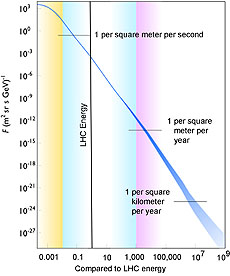Big mysteries: Ultra-high-energy cosmic rays
 |
Cosmic rays constantly pummel the Earth, some with energies far higher than even the Large Hadron Collider can generate. The most energetic cosmic rays can have energies as much as a billion times higher than the LHC beams.
|
Accelerator physicists at CERN are understandably pleased with themselves for having accelerated a beam of protons to the prodigious energy of 4 trillion electronvolts. However, when interviewed for this story, the universe had a jocular response: "A trillion electronvolts? How cute…"
How is it that the universe could react so blithely? Well, it's because the universe accelerates protons to energies far higher than that all the time. These high-energy cosmic protons are called cosmic rays. Through interactions involving supernovae, white dwarfs, black holes and all sorts of denizens of the heavens, protons can be accelerated to energies thousands, millions and occasionally even billions of times higher than is possible at the LHC. These particles occasionally slam into the Earth high in the atmosphere, and we can detect the debris of the collision that makes it down to the surface.
These very high-energy cosmic rays are very rare. If you took a hypothetical picnic blanket and somehow suspended it high above the Earth, only about one cosmic ray with an energy of a few thousand times that of LHC beams will pass through the blanket per year. If you wanted to see a cosmic ray with an energy 10 million times that of the LHC, you'd have to grow your picnic blanket to be half a mile on each edge and then wait a year for the unlikely cosmic ray to pass through it. And to get the very highest-energy cosmic rays, which are about a billion times the energy of the LHC, the blanket would have to be big enough to simultaneously cover Arizona, New Mexico, Colorado and Utah to see one per year.
Studying these very high-energy cosmic rays provides insights into some of the most violent phenomena in the universe. However, scientists are still unclear on the origins of the very highest-energy protons. For instance, the universe is full of low-energy photons called the cosmic microwave background. Protons moving through space encounter these photons and, through the collisions, slow down. If you calculate the distance the proton can travel, you'll find that these very high-energy protons must, cosmically speaking, have a local origin — within 160 million light years.
Recent observations using the Auger Observatory in Argentina have suggested that perhaps the origins of ultra-high-energy cosmic rays might be active galactic nuclei, which are thought to be galaxies in which a super-massive black hole at the galaxy's center is rapidly gobbling up nearby gas clouds. However, the pointing precision of the Auger Observatory is only good to about three degrees, leaving plenty of room for ambiguity. Improvements in the number of high-energy cosmic rays observed by the Auger facility will help resolve the questions.
There are other possible explanations for very high-energy cosmic rays, from decaying dark matter to powerful electromagnetic fields in radio galaxies. The bottom line is that we don't really know where these cosmic bullets are coming from.
Understanding these energetic messengers from the heavens will shed light on the cosmos. For now, they remain one of the universe's big mysteries.
—Don Lincoln
Want a phrase defined? Have a question? Email today@fnal.gov.
|